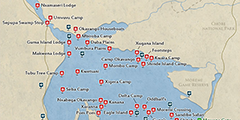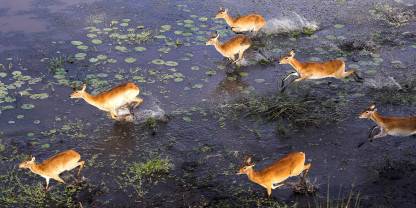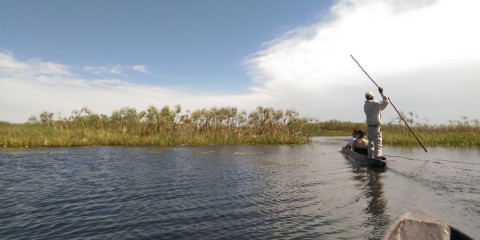The Okavango Delta is one of Africa’s most sought-after safari destinations and it has few rivals when it comes to watching wildlife. The Delta consists of a mix of private and community concessions, as well as Moremi Game Reserve. Together they offer a true wilderness experience with world-class wildlife viewing and stunning scenery. and trips are a great addition to the , which are a real Okavango specialty.

-
Best Time To Go
- July to October (Best wildlife viewing)
-
High Season
- July to October (Higher rates apply but it’s not busy)
-
Size
- 22,000km² / 8,494mi²
-
Altitude
-
934-1,024m /3,064-3,360ft
 View Photos
View Photos
 View Photos
+24
Photos
View Photos
+24
Photos
 Open Map
Open Map
Pros & Cons
- Excellent wildlife viewing with four of the Big Five easily spotted (and rhino difficult but possible)
- Off-road driving is permitted in most areas, which ensures high-quality sightings
- The Okavango Delta scenery is superb
- Great birding destination, especially for waterbirds
- , night drives, and trips are available
- A large choice of small, exclusive camps
- The Okavango can be an expensive destination
Wildlife
The Delta is a vast area and wildlife viewing can depend on your location. Lion, leopard, cheetah and wild dog are all possible, and can produce some exciting sightings. Rhino has been introduced into Moremi Game Reserve and the concessions run by &Beyond and Great Plains Conservation. Elephant, giraffe, zebra and buffalo are everywhere, and waterways are filled with hippo and crocodile. Antelope species can range from red lechwe and waterbuck to rarer species such as sitatunga, sable and roan.
More about Okavango Delta’s wildlifeScenery
The world’s largest inland delta, the Okavango is a picturesque place filled with many different habitats. It is fed by the river of the same name during the driest months. The fan-shaped delta is a mosaic of papyrus-fringed channels filled with water lilies and connecting wetlands. Islands in between carry borassus palms, acacia woodland and thickets of .
Activities
Guided (including off-road) and trips are the main activities in the Delta, and combining the two makes for a wonderful safari experience. In certain areas, including Moremi Game Reserve, self-guided game drives are an excellent way to explore, but they may not be an option in some private concessions. Night drives and are highlights in some areas outside Moremi.
Weather & Climate
The Okavango Delta’s Dry season runs from April to October, when afternoon temperatures are warm and pleasant. The heat builds through September and October until the rains break, marking the start of the Wet season (November to March). During this time the Delta starts to cool down a little. It remains reasonably hot in the afternoon, but mornings are usually pleasant. The heaviest rains are from December to February.
More about the weather and climateBest Time To Visit
Water levels are best for trips in the Dry season (April to October). This is also the best time to see wildlife, particularly from July onward, although the heat can be oppressive later in the season, especially during October before the rains break. You can still see animals in the heart of the Delta in the Wet season (November to March), but storms, impassable roads, closed lodges and lower water levels can all restrict activities.
More about the best time to visit



